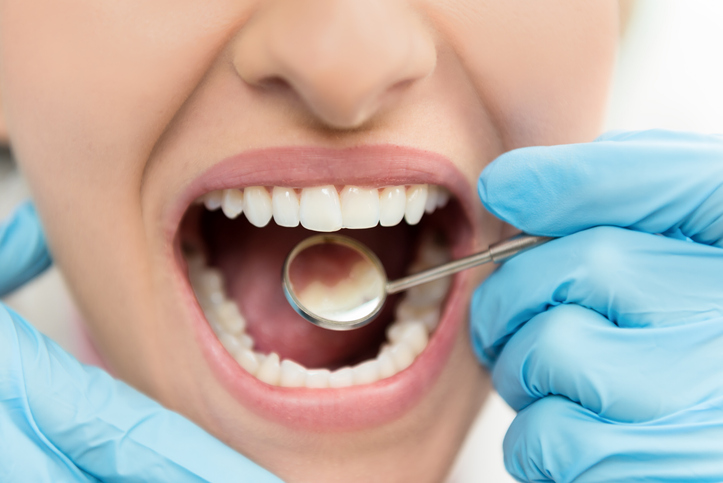-
Keto Diet and Dental Health

If you’re pursuing the ketogenic diet—characterized by very low carbohydrates, moderate protein, and high fat—you’re probably hoping to lose weight quickly. While this is one outcome of the keto diet, it also has some interesting effects on your dental health. Consider the positive and not-so-positive outcomes of the keto diet as it relates to your teeth, gums, and breath.
Keto Can Reduce Gum Inflammation
While the keystone of keto is to greatly restrict your carbohydrate intake, this diet also rich in omega-3 fatty acids, vitamins C and D, fiber, and antioxidants. In a 2016 study, keto was shown to decrease all gingival and periodontal inflammatory parameters by 50 percent. As a result, the keto diet could be useful for preventing or treating inflammation associated with gum disease.
The Keto Diet Can Cause “Keto Breath”
One unwanted side effect of the keto diet is unpleasantly fruit-scented breath. This happens because, when you drastically reduce your carb intake, your body enters a state called ketosis. In this state, your body burns stored fat and produces ketones, which the body uses as fuel in the absence of carbs.
One undesirable effect of this is called “keto breath.” While totally harmless, having bad breath can make you feel self-conscious. Follow these tips to alleviate keto breath while following your diet.
Drink More Water
Dehydration is a common symptom of the keto diet, especially at the beginning when your body is shifting from using carbs for energy to turning fat stores into energy. Dehydration, in turn, leads to dry mouth, which sets the stage for keto breath. That’s why the first secret to banishing this side effect is to drink more water.
Increase Your Oral Hygiene Efforts
If you notice a bad taste in your mouth, or your loved ones pull away in response to your keto breath, combat these symptoms by improving your oral hygiene. Here’s what we suggest:
- Brush after every meal and snack.
- Floss daily.
- Rinse with alcohol-free mouthwash to kill germs without drying out your mouth.
Watch Your Protein Intake
The keto diet calls for eating more protein, but don’t overdo it. Your body produces ammonia when it digests protein, and if you eat too much of it, the strong scent could be detectable on your breath.
Keep Mints on Hand
When all else fails, mask your keto breath with sugar-free mints. This temporary solution can help you feel more confident at social events and business meetings.
Keto isn’t the only cause of bad breath. If you try these tips but can’t seem to overcome your symptoms, visiting the dentist might help. Professional teeth cleaning can remove plaque and bacteria contributing to halitosis, or chronic bad breath. You can also receive more personalized tips from your dentist about how to prevent and treat bad breath.
To schedule your next appointment, please contact Glenwood Premier Dental at (732) 264-4477. Our dentist in Hazlet would be happy to offer tips to help freshen your breath!
-
How to Relieve a Toothache at Night

A toothache is no fun any time of day, but it’s especially disruptive at night. Here are some steps you can take to help you fall and stay asleep with a toothache. (Be sure to call your dentist in the morning to ask about setting a same-day appointment to treat this dental emergency.)
- Take pain medicine: A quick, simple way to deaden a mild-to-moderate toothache is to take over-the-counter painkillers such as acetaminophen or ibuprofen. For your safety, always follow the dosage on the packaging.
- Apply a cold compress: Wrap a bag of frozen peas in a towel and place it to your cheek where the affected tooth is located. This restricts blood flow in this area to reduce pain and inflammation so you can sleep. For the best results, apply the compress for 15 to 20 minutes on and off in the evening before going to bed.
- Elevate your head: Propping up your head with two pillows reduces blood flow to your aching tooth. This may relieve the pain so you can fall asleep.
- Apply medicated ointment: Over-the-counter oral numbing gel is an effective way to reduce the discomfort of a toothache at night.
- Rinse with saltwater: As a natural antibacterial agent, saltwater makes an effective mouth rinse. Add one-quarter teaspoon of salt to one-half cup of warm water. Swish a small amount in your mouth for 10 to 15 seconds, and then spit. The pain relief should be immediate.
- Rinse with hydrogen peroxide: If your toothache is caused by gum disease, a hydrogen peroxide rinse should help. Dilute food-grade hydrogen peroxide with an equal amount of water. You can also use a whitening mouthwash that contains hydrogen peroxide. Swish for 10 to 15 seconds, and then spit.
- Make peppermint tea: Peppermint contains menthol and antibacterial compounds. Swishing peppermint tea around your sore tooth or sucking on a peppermint tea bag can temporarily relieve your nighttime toothache.
- Apply a clove paste: Cloves contain eugenol, an analgesic with a mild numbing effect. Wet a small amount of ground cloves with water to form a paste and apply it to your sore tooth. You can also suck on a single clove and rest it near the painful area for relief.
- Chew on garlic: Garlic is widely used for its antibacterial effects. When placed in the mouth, a clove of garlic can kill the bacteria causing your toothache. Just be prepared for an intense taste and the lingering effects of garlic breath.
While these at-home remedies provide temporary relief for a toothache at night, you should never ignore lingering mouth pain. Toothaches could indicate an abscess, cracked tooth, trauma to the jaw, or gum disease, all of which require professional treatment.
If a tooth is bothering you, contact Glenwood Premier Dental at (732) 264-4477 right away. Our dentist in Hazlet will make every effort to see you the same day and relieve your pain once and for all!
-
The Unexpected Dangers of Gum Disease

When you think about dental health, you might picture straight, white teeth with no cavities. However, your gums are equally important and deserving of your attention. After all, keeping this soft tissue healthy doesn’t just prevent gum disease—it also helps you avoid a whole host of surprising, seemingly unrelated health problems. Here are some of the conditions that have an unexpected link to periodontal disease, according to a report published in Medical News Today.
Alzheimer’s Disease
Multiple studies have found a connection between poor gum health and decreased cognitive function. For example, an increased buildup of beta-amyloid—which is crucially involved in the development of Alzheimer’s disease—is found in periodontal disease patients.
Evidence also suggests that Porphyromonas gingivalis—a type of bacteria commonly found in periodontitis cases—is also present in the brains of Alzheimer’s patients. In fact, P. gingivalis infection is thought to boost the production of beta-amyloid in the brain.
Heart Disease
While gum disease and heart disease share some of the same risk factors—including smoking and drinking excessive alcohol—the association between the two doesn’t stop there. One theory is that inflammation links these diseases. If inflammation spurred by gum disease spreads to the cardiovascular system, heart disease could develop.
Another theory is that gum disease bacteria can enter the bloodstream and make their way to the heart, where they can cause inflammation and damage. This hypothesis is based on the fact that P. gingivalis is the most common bacterial species found in the coronary artery.
Cancer
Periodontal disease has been shown to correlate with increased cancer risk. This could be because gum disease bacteria produce a type of enzyme that commonly appears in certain tumors. This enzyme, which helps periodontal disease bacteria to infiltrate your gums, also activates other enzymes that allow cancer cells to advance faster into healthy tissue.
Erectile Dysfunction
Although gum health and sexual performance may seem a world apart, they share a common link: inflammation. As previously mentioned, inflammation in the mouth can spread to the blood and impact other parts of the body. Erectile dysfunction is often the result of malfunctioning blood vessels, which can occur because of the proinflammatory state in which gum disease puts your body.
Lung Disease
Once again, inflammation and bacteria are the most likely links between gum disease and lung disease. For instance, if gum inflammation spreads to the bronchial tubes, your airways may narrow and make breathing more difficult. It’s also possible to breathe bacteria from the mouth into your lungs, which could trigger an infection, inflammation, and even cancer.
Gum disease is preventable, yet nearly half of adults in the US have some form of the disease, which puts other aspects of their health at risk. You can prevent and treat gum disease with regular trips to the dentist. If you’re looking for a reliable dentist in Hazlet to take care of your teeth and gums, please contact Glenwood Premier Dental at (732) 264-4477 today.
-
The Worst Kinds of Halloween Candy for Your Teeth

What scares you the most on Halloween? Vampires and witches and werewolves might come to mind, but in reality, the spookiest part about trick-or-treating is all that candy—and the cavities it can cause.
Sugary snacks are your teeth’s worst enemies, yet on October 31, countless kids, teens, and even adults will indulge in heaps of the sweet stuff. Here’s a look at which candy is the worst for your teeth, some friendlier alternatives, and tips to keep your smile healthy on Halloween and beyond.
Halloween Candy Most Likely to Cause Cavities
- Sticky or gummy candy: The delightfully chewy quality of these sweets is also their downfall. Traces of candy can lodge themselves between your teeth and on the biting surface of your molars. The longer that sugar sticks to your teeth, the higher your cavity risk becomes.
- Hard candy: If you suck on hard candy, it doesn’t come in direct contact with your teeth, but the sugar mixes with your saliva and lingers in your mouth, sometimes for five minutes or longer. If you pop in piece after piece, sugar attacks your teeth constantly, and your saliva can’t do its job of washing away debris and cleaning out your mouth.
- Sour candy: As if the sugar in gummy or hard candy wasn’t enough, candy companies also sell sour candy. Citric acid weakens the outer layer of your teeth, known as enamel, increasing the risk of decay. It’s a double blow your teeth don’t need.
More Tooth-Friendly Candy Options
- Dark chocolate: Chocolate doesn’t stick to your teeth or linger in your mouth the way other candies do. Dark chocolate also has less sugar than white or milk chocolate, along with surprisingly high antioxidant and mineral content to promote good health when enjoyed in moderation.
- Sugar-free gum: Chewing on gum can feel similar to eating candy, but as long as it’s sugar-free, it has almost no calories and increases saliva flow to reduce plaque buildup and tooth decay.
- Candy sweetened with xylitol: Xylitol is a naturally occurring sugar alcohol that tastes sweet without increasing cavity risk. In fact, xylitol reduces tooth decay and can even reverse cavities in their early stages. You can find xylitol-sweetened candy in many forms, including suckers, gummies, and chewing gum.
Good Oral Habits for a Healthy Smile
If a mouthful of cavities is more frightening to you than ghosts and ghouls, protect yourself by following these tips—not just on Halloween, but all year-round:
- Brush your teeth morning and night.
- Floss once a day.
- Rinse your mouth with water after raiding your Halloween candy stash. Better yet, brush your teeth as soon as possible.
- Visit the dentist every six months for professional teeth cleaning.
- Consider preventative measures such as dental sealants, mouthguards, and fluoride treatments.
For more tips to maintain a healthy smile, or to schedule your next appointment, please contact our dentist in Hazlet at (732) 264-4477.
-
Tips for a Sweet, Cavity-Free Halloween

As a holiday based almost entirely on getting and eating as much candy as possible, Halloween may seem destined to cause more than a few cavities across the country this year. Thankfully, with a few simple tips, you can minimize the sugar overload without taking the fun out of trick-or-treating.
Devise a Candy Plan
The best way to make sure you and your kids have the same expectations regarding Halloween candy is to talk about it before the holiday arrives. You have a few options for restricting the amount of candy your children ingest:
- Limit the number of houses you visit.
- Give your children a smaller bucket or bag to take trick-or-treating.
- Parcel out the candy slowly over the year, such as by allowing a piece or two for dessert each day.
Whatever methods you choose, include your children in the conversation. Explain that you’re not limiting their candy intake to be mean—you want to help them make a healthy choice for their teeth and body.
Consider a Candy Swap
If you don’t feel comfortable allowing your child to have a bucket of candy, even if you spread out its consumption, consider another option called a candy swap. This is when you trade the candy your child earned from trick-or-treating with a sugar-free reward.
You might do this all at once by replacing the whole pile of candy with a toy your child has wanted for a while. You can also do it piecemeal, offering small rewards such as stickers, colored pencils, or anything else you think your child would enjoy in exchange for individual pieces of candy.
Hand Out Sugarless Treats
If you don’t want a mountain of candy in your own home, don’t give it out to the neighborhood kids. You have plenty of sugar-free options to offer the vampires, ghosts, and witches that knock on your door, including:
- Pretzels
- Raisins
- Plastic spider rings
- Sticky hands
- Glow-in-the-dark critters
- Halloween-themed pencils and erasers
- Mini slinky toys
- Small boxes of crayons
- Mini glow sticks
Remember to Brush and Floss
It doesn’t matter whether your children eat one piece of candy or 10—after Halloween is over, ensure that they brush their teeth. Make this a habit every morning and night to help prevent tooth decay. A fun new toothbrush may help get your children excited about brushing.
Also, don’t forget the importance of flossing. As soon as two of a child’s teeth touch, food can get stuck between them, especially gummies and other chewy candy. Help children with brushing and flossing once they reach age 6 or 7 to make sure they’re doing it correctly. After that, continue to monitor them until you’re confident they have the hang of it.
Clearly, Halloween doesn’t have to be scary for your kids’ oral health! For more tips, or to schedule your family’s next dentist visit, please contact Glenwood Premier Dental in Hazlet at (732) 264-4477.
-
How to Know When it’s Time to Visit the Dentist

The changes that occur in your mouth usually happen gradually. This can make it difficult to tell when it’s time to visit the dentist. Watch for these signs that you should schedule your next appointment sooner rather than later.
It’s been six months since your last visit.
The American Dental Association recommends visiting the dentist regularly. For most people, this means scheduling an exam and cleaning twice a year. If you have periodontal disease or other health problems related to your teeth or gums, you may need more frequent visits than this. Follow your dentist’s advice about how often to schedule appointments.
You feel self-conscious about stained or discolored teeth.
Seeing the dentist every six months is largely about catching and treating cavities, gingivitis, oral cancer, and other health problems as early as possible. However, it’s also about helping you maintain a smile you can be proud of. If coffee, tea, and acidic foods have started to leave their mark on your teeth, you don’t need to wait six months for your next cleaning. Many patients schedule dentist appointments every three to four months to ensure they can always smile with confidence.
Teeth whitening is another cosmetic dental procedure that might encourage you to visit the dentist sooner rather than later. With professional in-office whitening, you can achieve the gorgeous white smile you have always wanted in under an hour.
You experience pain or sensitivity in your mouth.
From dull pain to throbbing toothaches, any pain in your mouth is worth checking out. Sudden sensitivity to hot and cold food and drinks is also a cause for concern, especially if it affects your everyday activities. If you find that changes in your mouth are affecting your ability to sleep, speak, and eat, you should see your dentist as soon as possible.
Your denture, bridge, or other oral appliance isn’t fitting well anymore.
Teeth tend to shift over time, so if any dental work or removable appliance feels too tight, too loose, or simply “off,” talk to your dentist about getting an adjustment.
Your gums bleed significantly when you brush or floss.
A little blood in your toothpaste or on your floss isn’t a huge concern, but if the bleeding is significant or lasts for weeks after establishing a flossing routine, this could indicate an issue with your gums. If left unaddressed, you could develop periodontal disease.
You injure or knock out a tooth.
Emergency dentists offer same-day service for loose and knocked-out teeth. These situations call for immediate action to help save the damaged tooth. If you or your child needs emergency dental care for these or other reasons, call your dentist right away.
Glenwood Premier Dental offers a variety of cosmetic and restorative dental treatments to help you maintain a healthy, beautiful smile. Contact us today at (732) 264-4477 to let us know how our dentist in Hazlet can help you!
-
Four Benefits of Teeth Whitening

Your smile is the first thing most people notice about you. Are you self-conscious about your yellowing, stained teeth? Teeth whitening may only be cosmetic, but it’s a dental service many patients consider to be worthwhile. Here are four reasons why.
Enhance Your Appearance
You might have healthy, straight teeth with no cavities in sight, but a dull, stained smile can still turn people off. Whether your goal is to look good on a first date or get that promotion at work, whiter teeth can help your cause.
According to a 2012 survey by the American Academy of Cosmetic Dentistry, 96 percent of adults believe that having an attractive smile makes you more appealing as a partner. Then, 74 percent of respondents feel that an unattractive smile could hurt a person’s chances of excelling in their career. “Discolored, yellow, and stained teeth” were listed as factors that could make a smile unattractive.
Improve Your Self-Esteem
If you find yourself smiling with your lips together or feeling self-conscious when you notice someone looking at your mouth, it could be time for a teeth whitening session. When you know your teeth look good, you’re more likely to smile naturally instead of trying to hide your mouth. This helps you feel and act more confident, whether you’re on a date, giving a presentation, or attending a big event.
Draw Positive Attention to Your Smile
People assume a lot about you based on your smile. For instance, white teeth give off the impression that you live a healthy lifestyle, while stained teeth could make you appear less hygienic. Of course, this isn’t a fair assessment, since healthy habits such as drinking green tea and eating berries can stain your teeth.
With teeth whitening, you can leave a different impression, one that says you care about your appearance and health habits. A bright smile may even distract people from other features you feel insecure about, such as wrinkles, frown lines, or acne scars.
Enjoy a Whiter Smile at a Low Cost
Some people reach for over-the-counter products to whiten their teeth. While these options are cheaper than in-office whitening, the results are also limited.
Professional bleaching is the best way to noticeably whiten your smile in a single visit. The cost is far lower than other cosmetic procedures available to improve your appearance today. Plus, with an at-home touch-up kit, you can prolong the effects of professional whitening. This combination enhances your smile significantly with a small overall price tag.
Glenwood Premier Dental offers professional in-office teeth whitening and other cosmetic dentistry services so you can enjoy all these benefits to the fullest! To learn more about this procedure, or to schedule a consultation our Hazlet dentist, please contact us at (732) 264-4477 today.
-
Five Facts About Fluoride

What do you know about fluoride? As nature’s cavity fighter, fluoride is the key ingredient in most toothpastes and mouth rinses. You can also receive fluoride treatments at the dentist office. Here are five facts you might not have known about fluoride.
Fluoride is an element found in nature.
Even though you’re accustomed to hearing about fluoride in dental products, it’s not a lab-made chemical. In fact, fluoride is found in the earth’s crust, oceans, and atmosphere. As the 13th most abundant element on earth, it’s quite easy to come by. Tea plants, seawater, and volcanic rocks have relatively high concentrations of fluoride. Even some foods, such as fish, chicken, and rice, contain small amounts of fluoride.
Fluoridating municipal drinking water dates back 75 years.
In 1945, Grand Rapids, Michigan became the first city in the US to fluoridate its drinking water. The decision came after research in the 1930s revealed that people growing up in areas with naturally fluoridated water had up to two-thirds fewer cavities than people with little to no fluoride in their water. The American Dental Association, World Health Organization, and many other groups recognize water fluoridation as the single most effective public health measure to prevent tooth decay.
Fluoride strengthens teeth.
Whether ingested in your drinking water or applied directly to your teeth, fluoride helps prevent cavities in two ways. First, it hardens the enamel of developing teeth before they emerge through the gums.
Second, it hardens the calcium and phosphorous that your saliva deposits onto your teeth during the remineralization process that occurs naturally in your mouth. This makes the enamel harder than it would be otherwise, decreasing the risk of cavities in the process.
Most bottled water doesn’t contain fluoride.
The recommended fluoride level in community drinking water is one part per million. This promotes the proper intake for the average adult of 1.4 mg to 3.4 mg. If you drink mostly bottled water, you may not be getting enough fluoride.
Check the brand of bottled water you buy to see if it contains this vital nutrient. Then, discuss any concerns with your dentist. You or your children may be advised to take fluoride supplements in the form of tablets, drops, or lozenges. Your dentist can prescribe the proper dosage. Be sure to brush twice a day with fluoride toothpaste as well.
Too much fluoride can be detrimental.
Swallowing too much fluoride toothpaste or taking too many fluoride supplements can cause mild discoloration of developing teeth before they erupt from the gums. This condition, called dental fluorosis, only occurs in children who still have baby teeth, but the effects are permanent. Skeletal fluorosis is a rare disease that affects children and adults. However, it only develops if a person consumes significantly higher-than-average amounts of fluoride.
If you’re interested in fluoride treatments or supplements, contact our dentist in Hazlet at (732) 264-4477 to learn more. We can also answer questions about fluoride exposure and any other oral health concerns you have.
-
Five Tips for Preventing Periodontal Disease

Periodontal disease is a sneaky condition. Even people who brush and floss daily are not immune, and people are often unaware that there is a problem until the disease has become serious. When left untreated, periodontal disease, or gum disease, can lead to infections, gum pain, and tooth loss. In fact, periodontal disease can have an impact on the overall health of your body, because it has been associated with a higher risk of heart disease, stroke, and even cancer. Nearly half of the population of the United States has gum disease, but there is good news. With a few simple precautions, you can protect your mouth from periodontal disease.
- Clean your teeth thoroughly. At least twice a day, brush your teeth for at least two minutes to remove food debris and plaque. While you’re brushing, make sure to brush your tongue, where bacteria loves to hide. Swish with mouthwash after brushing, to reduce plaque and remove particles that may have been missed, and floss at least once a day.
- Visit your dentist regularly. At least once a year, have your teeth cleaned by professionals. Dentists have the necessary professional cleaning tools to get rid of plaque and tartar on your teeth and in your gums. Your dentist can also discover signs of periodontal disease, and advise you on how best to care for your teeth.
- Understand your risk of periodontal disease. Your risk for periodontal disease increases as you age, but smoking, diet, and genetics also play a part. If you are at increased risk, bring this up with your dentist. He or she may recommend a visit to the periodontist.
- Quit the bad habits that are putting you at risk. Smoking, eating a lot of sugar, and eating late at night are all habits that increase your risk of gum disease. If you must have a snack after you’ve brushed your teeth for the night, brush them again so that food particles don’t stay in your mouth overnight.
- Keep an eye on your teeth. Look for early signs of periodontal disease, because as the disease progresses, it gets worse and does more damage. Pay special attention to gums that bleed when you brush or floss, seeing your dentist to report this as soon as possible.
If gum disease progresses to an advanced stage, your dentist may recommend periodontal therapy. This requires multiple appointments, treating one region of the mouth at a time while the area is numb. Tartar, plaque, and toxins are removed from above and below the gum tissue, and rough spots on root surfaces are smoothed. This allows the gum tissue to heal and periodontal pockets to shrink. In some cases, periodontal disease must be treated with surgery. In a surgical procedure known as flap surgery, the doctor pulls apart the gum and removes tartar from deep pockets. It’s much easier and less expensive to care for your teeth properly before it gets to that point and to have regular appointments with a well-qualified dentist.
At Glenwood Premier Dental, we believe that a healthy, confident smile is an important part of a happy and healthy lifestyle. Our staff of caring professionals is committed to offering a wide range of dental services, exceeding our patients’ expectations, and providing the best possible service. We offer dental exams and teeth cleanings, implant dentistry, Invisalign, laser dentistry, teeth whitening, veneers, and more, using state of the art technology in a comfortable and friendly environment. If you’re looking for dental care in Hazlet, contact us through our website or call 732.264.4477 for more information.
-
Playing the Part of The Perfect Tooth Fairy

The loss of a child’s first tooth is such a fun milestone! Are you ready for it? For over a century losing a tooth been a rite of passage that involves magic, as the tooth fairy collects a tooth left under the child’s pillow and leaves a small gift in exchange. This used to be a little bit of money, but in the Pinterest age, the game has changed, and being the perfect tooth fairy may require a little bit of creative thinking.
Before we get to the magic part though, it’s only fair to address something that first-time parents might not have considered. The whole losing a tooth thing is pretty disgusting. First of all, you have a child with a loose tooth, and most of them basically refuse to keep their hands off of it. They wiggle it back and forth, and some of them refuse any assistance until the thing is basically hanging on by a thread. Then, when you finally persuade the child to let you just pull the tooth already, what is your reward? You’re standing there with a tooth in your hand, which is not really something most of us want.
Once that ordeal is done, and the blood is rinsed down the drain, it’s time for the magic to begin. How do children even know about the tooth fairy? It seems like something they’re born knowing, but if your child wants a tooth fairy origin story, you can find one here, all about how the tooth fairy uses the teeth she collects to build a castle. When your child is sold on the concept of trading teeth for loot, the next step is to determine where to hide the teeth. Under the pillow is traditional, of course, but it’s more challenging than you might think to root around under a child’s pillow in the middle of the night. Consider a cute tooth fairy pillow, with a pocket to securely hold the tooth.
Now, decide on your ritual. You might want to talk to some friends about the going tooth fairy rate because it can vary pretty widely. Some kids get change, while others get bills, and it’s good to know the consensus in your social circle before you choose something too far off from what your child will hear from the other kids. For older kids, cash is king, but with little kids, you might consider skipping the money in favor of a small trinket, book, or another prize. Remember, though, that whatever you do the first time will set the bar for the rest of your tooth fairy years. If you overshoot, you may regret it about 15 teeth from now.
There’s more to the tooth fairy than money and prizes, though. Some parents leave notes from the tooth fairy, written with a special pen in some very fancy handwriting, giving advice on dental hygiene. Others leave glitter somewhere, either sprinkled over the bed or in tiny footprints that meander through the house. What your tooth fairy does is up to you, so have fun with it!
Once you’ve glittered and gifted, you’re left, once again, holding a tooth. What should you do with it? This is another thing that’s entirely up to you, but we suspect that most parents have a secret tooth stash somewhere in the house. It’s a little bittersweet, that first little lost tooth, because it probably seems like just a minute ago that you were watching that tooth grow into your baby’s little pink gums. No one will blame you if you get a little sentimental and decide to hang onto those little teeth.
From the moment those first teeth erupt into that gummy grin, they’re yours to care for. It’s a big responsibility, so it helps to have a dentist you trust as a partner in your child’s oral health. At Glenwood Premier Dental, we believe that a healthy, confident smile is an important part of a happy and healthy lifestyle. Our staff of caring professionals is committed to offering a wide range of dental services, exceeding our patients’ expectations, and providing the best possible service. We offer dental exams and teeth cleanings, implant dentistry, Invisalign, laser dentistry, teeth whitening, veneers, and more, using state of the art technology in a comfortable and friendly environment.
